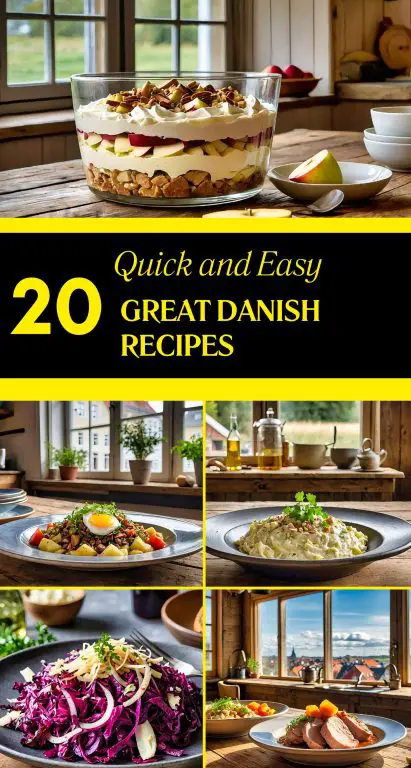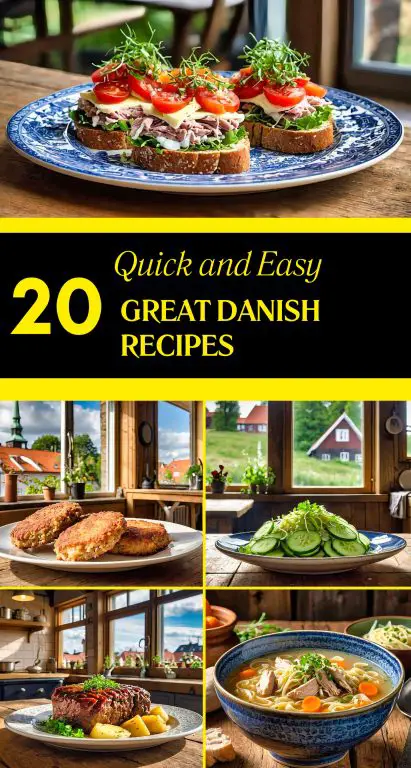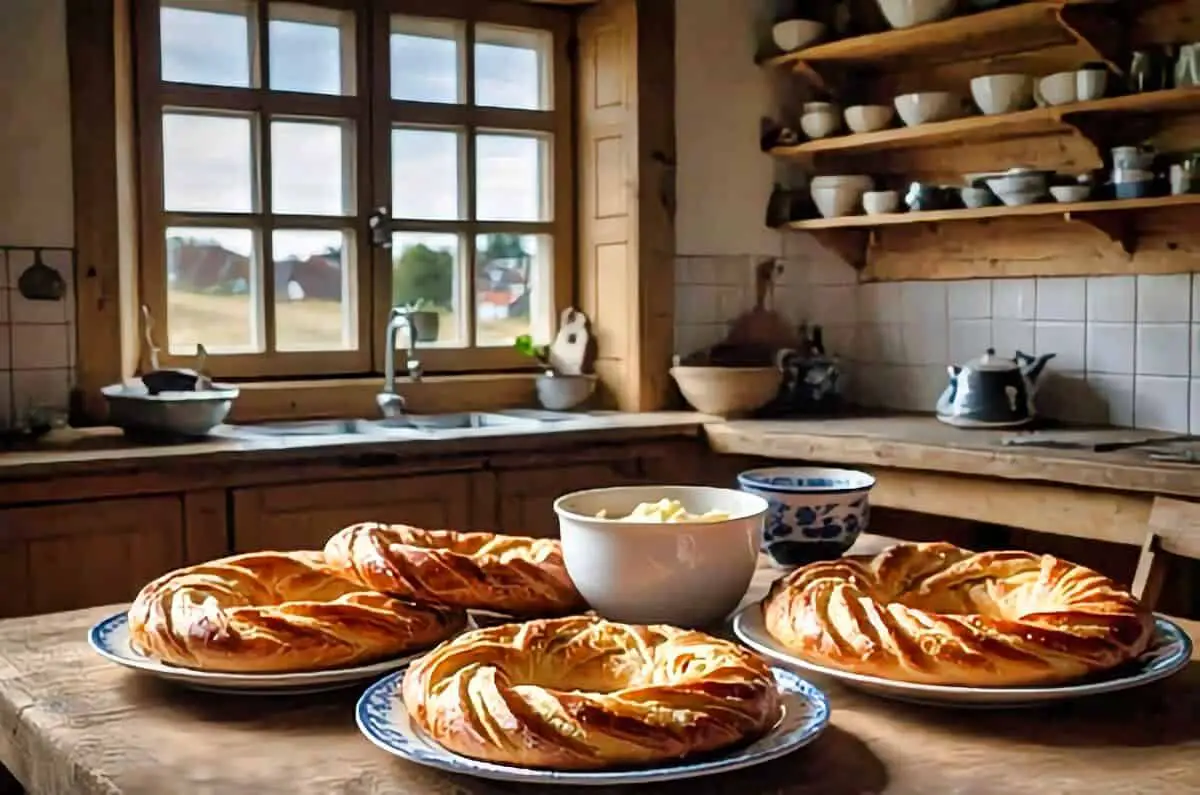The Danish Kringle recipe was the highlight of my visit to Roskilde, a historical and cultural town in Denmark. Roskilde is a medieval village just a train ride from Copenhagen. Cobbled streets lined with shops, cafes and colourful buildings can be explored on foot. Attractions consist of the Roskilde Cathedral (a UNESCO World Heritage Site) and the Viking Ship Museum because of its authentic Viking history and ships.
During my stay I tried my hand at local food by taking a cooking class on the Danish Kringle. This pastry is common in the region and is generally consumed with tea or coffee. The class was held in a tiny kitchen studio in the centre of the town, that has old world charm mixed with modern Danish design.
The instructor showed us how to make the dough, shape it into the twisted pattern and make the almond filling. This was my 1st attempt at creating a traditional Danish pastry; I was struck by the ease of the materials and the attention to method. Locals often make this Danish Kringle recipe for gatherings and special occasions.
The golden crust was slightly crisp when the pastry was out of the oven and the inside was firm and layered. The filling was ground almonds, butter and sugar – it was slightly nutty. The texture was light but firm enough to go with a hot beverage. It was easy to understand the reason why this particular dish is still a favorite in Danish homes.
Apart from the cooking class, Roskilde has much to offer. The town’s market square with its fresh produce and artisanal goods is a good place to sample local culture. For those interested in history, the Roskilde Museum gives a better insight into the town’s Viking heritage and its evolution over centuries.
In general, learning the Danish Kringle recipe was a practical and interesting way to connect with the Roskilde traditions. The dish itself is a combination of simplicity and taste reflecting the Danish way of eating and living. If you visit, taking the time to try or learn this recipe is a must.

Ingredients
For the Pastry Dough
All-purpose Four
Bread Flour
Sugar Granulated
Yeast
Sea Salt
Butter
Milk
Egg
Egg whites
For the Kringle Filling
Pecans
Brown Sugar
Butter
For the Icing
Sugar Powdered
Vanilla Extract
Sea Salt
For the Salted Caramel Glaze
Butter
Sugar
Whipping Cream
Sea Salt
Cooking Instructions
For the Dough
- In a mixing dish, combine the yeast, sugar, salt, and flours. Stir to combine. After that, put the ingredients into a food processor. After adding the butter, pulse the processor about twelve times. You should cut the butter into halves before using it.
- Put the milk and egg in a big bowl and mix for a few seconds with a table fork or whisk, if you have one. Be careful not to overmix the dry ingredients when you add them to the egg mixture. Knead the dough for a few minutes by hand before setting it on a clean, hard surface. Roll or pat the dough into a rectangle or square, then cover in plastic and seal. Save for at least six hours, preferably at least 48.
- Roll out the dough to a rectangle about 9 by 15 inches on a hard, clean, and lightly floured work surface. With approximately a third of the dough on each end, gather the short ends of the dough and fold them in toward the middle. After you’ve rolled and folded the dough, turn it 90 degrees and continue with the same measurements. Wrap in kitchen wrap and set aside to chill for half an hour.
Go through the previous step again. You may either use the dough right away or cover it in plastic and refrigerate it for at least 48 hours. Alternatively, you can freeze it for up to three months.
For the Kringle Filling
- Gather your nuts, brown sugar, and butter and mix them together in a big basin.
Get Ready to Shape and Bake! - Lining two large cookie sheets with parchment paper is a good idea. Split the cold dough in half lengthwise.
Shaping and Baking
- Form each ball of dough into a rectangle that is about 5 by 20 inches in size on a clean, hard surface that has been lightly dusted with flour. Leave approximately a 2 1/2-inch border on all sides as you evenly distribute approximately half a cup of filling along the middle of each dough ball.
Roll out one long side of each dough ball and fold it over the filling. Then, using the egg whites, brush an egg wash over the opposite side that has been unfurled and both ends. After that, follow the pictures up there to learn how to fold the long side over to the other side. Pinch and close the side and end seams tightly with your fingertips. - It is possible that the kringle dough has shrunk in size at this stage. Gently lengthen it to a measurement of twenty to twenty-four inches if required. Form a circle or oval (like a racetrack) by joining the two ends of each piece of folded dough. Use your fingertips to push and secure the ends together tightly. After that, line a baking sheet with parchment paper and set each unbaked kringle on top. To make the seam face down, invert or flip them. Put the cookie sheets in a warm spot and cover with a kitchen cloth or kitchen wrap. Just give the dough a good 45 minutes to rise.
- The kringle should be baked at 375 degrees. Preheating the oven is an absolute must. Toss them in an egg wash before baking. About 20 minutes into the baking process, you should see a golden brown hue. At approximately 12 minutes, rotate the baking sheets and swap the racks in the oven from the top to the bottom. Doing so will guarantee an even baked kringle.
- Upon removal from the oven, these will be quite hot. Removing any air pockets from the filling and crust can be achieved by delicately placing one baking sheet on top of the other kringle, followed by the other. Next, set a wire cooling rack on top of each.
Prepare the Icing and Frosting
- Combine 3–4 teaspoons of water or milk with the powdered sugar, vanilla, and sea salt in a small bowl. Spread the icing evenly over the tops of the pastry using an off-set spatula or a rubber one. Let it dry completely.
- Regarding the salted caramel topping: Butter should be melted over medium-low heat in a sturdy small pot. Add the granulated sugar and packed brown sugar and mix well. While stirring continuously, bring to a boil. Before returning to a boil, whisk in the heavy cream. Stir continuously while boiling for 2 minutes. Take it off the stove and mix in the sea salt. Allow to cool totally. Coat the icing with the glaze.

The Favorite Food of Danish Locals
Denmark is a country celebrated for its rich food heritage, with a focus on fresh, local ingredients and traditional cooking methods. Danish cuisine has gained international recognition, but the local favourites often revolve around comforting, everyday dishes that reflect the simplicity and quality of Nordic food culture.
Smørrebrød: The Iconic Open-Faced Sandwich
Denmark’s most popular dish is an open-faced sandwich on rye bread called Smørrebrød. This staple may be topped with pickled herring and cured meats, shrimp, or eggs, or seasonal vegetables. Danish locals enjoy smrrebrd for lunch or on special occasions. Rye bread (rugbrd) is one of the main dishes in Danish cuisine, prized for its thick, nutty taste.
Frikadeller: A Family Favorite
Frikadeller are Danish meatballs that are seasoned with onion, salt, pepper and allspice in the hearts of ground pork, beef or veal. They are pan-fried to golden perfection with boiled potatoes, creamy gravy and pickled red cabbage. Frikadeller are a staple at family dinners and are loved for their softness and comforting appeal.
Rugbrød: The Foundation of Danish Meals
Rugbrød is dense, dark rye bread, a cultural staple. It is a staple food for Danish locals, packed with nutrients and fibre. Often paired with cold cuts, cheese, or fish, rugbr’d is celebrated for its rich flavor and versatility. Some Danes make their very very own bread at home.
Flæskesteg: A Festive Delight
Flæskesteg (roasted pork with crispy crackling) is a traditional Christmas dish in Denmark. This traditional dish calls for pork loin seasoned with salt and sometimes cloves and roasted for crackling. It is served with caramelised potatoes, red cabbage and savoury gravy and is a traditional dish of Danish hospitality and cuisine.
Danish Pastries: A Sweet Treat
Danish pastries wienerbrød remain a local favorite, although internationally known. From custard-filled spandauerto jam-topped tebirkes, these buttery, flaky delights come in many shapes and flavors. They are usually eaten with a cup of coffee during the afternoon break kaffepause.
Hygge on a Plate
Danish food is strongly associated with Hygge, cosiness and contentment. Meals are often simple but prepared with care, using seasonal and quality ingredients. Whether it’s a light lunch of smørrebrød or a festive dinner with flæskesteg, Danish locals value food, family and tradition.
Every bite in Denmark is a story of heritage, community and respect for the land. For visitors, tasting these favourite dishes is a delicious way to taste the heart of Danish culture.
15 Essential Ingredients for Danish Cooking
Danish cooking revolves around fresh, seasonal ingredients that highlight the simplicity and natural flavours of Nordic cuisine. These essential ingredients are versatile and form the basis of many traditional Danish recipes. Here’s a closer look at the key components of Danish kitchens:
1. Rye Flour Rye flour is indispensable in Danish baking, especially for making rugbrød (rye bread). This dense, nutrient-rich bread serves as the foundation for many meals, including the iconic open-faced sandwiches, smørrebrød.
2. Potatoes Potatoes are a cornerstone of Danish cooking, featured in dishes like boiled potatoes, potato salads, and mashed potatoes. They are often served as a side with meat or fish.
3. Dill Dill is a popular herb in Danish cuisine, used to season fish, potatoes, and sauces. Its fresh, aromatic flavour is synonymous with Nordic cooking.
4. Cream Cream is a common ingredient in Danish dishes, adding richness to soups, sauces, and desserts like rice pudding (risalamande).
5. Pork Pork is the most commonly consumed meat in Denmark. It’s featured in recipes like flæskesteg (roast pork) and frikadeller (meatballs).
6. Pickled Vegetables
Pickled cucumbers, onions, and beets are used as condiments or sides, adding tanginess and crunch to meals.
7. Herring Herring, often pickled or smoked, is a staple ingredient in Danish cuisine. It’s a key component of traditional lunch platters.
8. Butter Danish butter, known for its high quality, is essential in cooking and baking, lending a rich flavour to dishes and pastries.
9. Onions Onions, both raw and cooked, are widely used in soups, stews, and salads. They provide a strong, savoury base for many recipes.
10. Eggs Eggs are a versatile ingredient, used in baking, sauces, and as a topping for smørrebrød.
11. Horseradish Horseradish adds a sharp, spicy flavour to sauces, seafood dishes, and garnishes, making it a must-have for Danish cooking.
12. Sugar Sugar is used to balance the acidity of pickled foods, as well as in desserts and baked goods like Danish pastries (wienerbrød).
13. Bay Leaves Bay leaves are used to add depth to soups, stews, and marinades, giving a subtle herbal aroma to many traditional dishes.
14. Fish In addition to herring, other fish like cod and plaice are widely used in Danish cooking, often prepared pan-fried or smoked.
15. Cheese Cheese, particularly creamy and aged varieties, plays a role in Danish cuisine, both as a topping for bread and as part of a meal.
These 15 ingredients form the essence of Danish cooking, reflecting the country’s commitment to fresh, simple, and flavourful food. From the richness of cream and butter to the tang of pickled vegetables, each ingredient contributes to the unique character of Nordic dishes.
FAQ For the Danish Kringle Recipe
Q: What is a Danish Kringle recipe?
A Danish Kringle recipe is a traditional Danish pastry made with a flaky dough and typically filled with almond paste, sugar, and butter. It is shaped into a distinctive twisted or oval form and often garnished with icing or nuts.
Q: Can I make a Danish Kringle recipe at home without special equipment?
Yes, a Danish Kringle recipe can be made at home using basic kitchen tools such as a rolling pin, mixing bowls, and an oven. The process involves simple techniques for preparing the dough and assembling the pastry.
Q: Is the Danish Kringle recipe suitable for beginners in baking?
The Danish Kringle recipe is a great choice for beginners because it uses straightforward ingredients and clear steps. While shaping the kringle requires some practice, the recipe is forgiving and delivers delicious results even on the first try.
Q: What are the key ingredients in a Danish Kringle recipe?
A Danish Kringle recipe typically includes flour, butter, sugar, yeast, milk, and almond paste or other fillings like cinnamon or fruit preserves. These ingredients create the rich, flaky texture and signature taste of the kringle.
Q: Where can I learn to make an authentic Danish Kringle recipe?
You can learn an authentic Danish Kringle recipe through cooking classes, online tutorials, or recipe books focused on Danish cuisine. Visiting Denmark, especially towns like Roskilde, offers opportunities to learn the recipe from local experts.

Danish Kringle Recipe Class In Roskilde Denmark
Ingredients
For the Pastry Dough
- 1 cup all-purpose flour
- 1 cup bread flour
- 3 tbsp sugar granulated
- 2 tsp instant yeast
- 1 tsp sea salt fine
- 1 cup butter unsalted cold, cut into 1/2" pieces
- 1/3 cup whole milk cold
- 1 egg large
- 1 egg white for egg wash
For the Kringle Filling
- 1 1/2 cups pecans finely chopped
- 1 cup brown sugar firmly packed
- 1/2 cup butter room temperature
For the Icing
- 1 cup sugar powdered
- 1 tsp vanilla extract
- 1/8 tsp sea salt
- For the Salted Caramel Glaze
- 1/4 cup butter unsalted
- 1/4 cup sugar granulated
- 1/4 cup sugar brown packed
- 1/2 cup whipping cream
- 1/2 tsp sea salt to taste
Instructions
For the Dough
- In a mixing dish, combine the yeast, sugar, salt, and flours. Stir to combine. After that, put the ingredients into a food processor. After adding the butter, pulse the processor about twelve times. You should cut the butter into halves before using it.
- Put the milk and egg in a big bowl and mix for a few seconds with a table fork or whisk, if you have one. Be careful not to overmix the dry ingredients when you add them to the egg mixture. Knead the dough for a few minutes by hand before setting it on a clean, hard surface. Roll or pat the dough into a rectangle or square, then cover in plastic and seal. Save for at least six hours, preferably at least 48.
- Roll out the dough to a rectangle about 9 by 15 inches on a hard, clean, and lightly floured work surface. With approximately a third of the dough on each end, gather the short ends of the dough and fold them in toward the middle. After you've rolled and folded the dough, turn it 90 degrees and continue with the same measurements. Wrap in kitchen wrap and set aside to chill for half an hour.
- Go through the previous step again. You may either use the dough right away or cover it in plastic and refrigerate it for at least 48 hours. Alternatively, you can freeze it for up to three months.
For the Kringle Filling
- Gather your nuts, brown sugar, and butter and mix them together in a big basin.
- Get Ready to Shape and Bake!
- Lining two large cookie sheets with parchment paper is a good idea. Split the cold dough in half lengthwise.
Shaping and Baking
- Form each ball of dough into a rectangle that is about 5 by 20 inches in size on a clean, hard surface that has been lightly dusted with flour. Leave approximately a 2 1/2-inch border on all sides as you evenly distribute approximately half a cup of filling along the middle of each dough ball.
- Roll out one long side of each dough ball and fold it over the filling. T
- hen, using the egg whites, brush an egg wash over the opposite side that has been unfurled and both ends. After that, follow the pictures up there to learn how to fold the long side over to the other side. Pinch and close the side and end seams tightly with your fingertips.
- It is possible that the kringle dough has shrunk in size at this stage. Gently lengthen it to a measurement of twenty to twenty-four inches if required. Form a circle or oval (like a racetrack) by joining the two ends of each piece of folded dough. Use your fingertips to push and secure the ends together tightly. After that, line a baking sheet with parchment paper and set each unbaked kringle on top. To make the seam face down, invert or flip them. Put the cookie sheets in a warm spot and cover with a kitchen cloth or kitchen wrap. Just give the dough a good 45 minutes to rise.
- The kringle should be baked at 375 degrees. Preheating the oven is an absolute must. Toss them in an egg wash before baking. About 20 minutes into the baking process, you should see a golden brown hue. At approximately 12 minutes, rotate the baking sheets and swap the racks in the oven from the top to the bottom. Doing so will guarantee an even baked kringle.
- Upon removal from the oven, these will be quite hot. Removing any air pockets from the filling and crust can be achieved by delicately placing one baking sheet on top of the other kringle, followed by the other. Next, set a wire cooling rack on top of each.
Prepare the Icing and Frosting
- Combine 3–4 teaspoons of water or milk with the powdered sugar, vanilla, and sea salt in a small bowl. Spread the icing evenly over the tops of the pastry using an off-set spatula or a rubber one. Let it dry completely.
- Regarding the salted caramel topping: Butter should be melted over medium-low heat in a sturdy small pot. Add the granulated sugar and packed brown sugar and mix well. While stirring continuously, bring to a boil. Before returning to a boil, whisk in the heavy cream. Stir continuously while boiling for 2 minutes. Take it off the stove and mix in the sea salt. Allow to cool totally. Coat the icing with the glaze.


1 comment
Super nice holiday treat